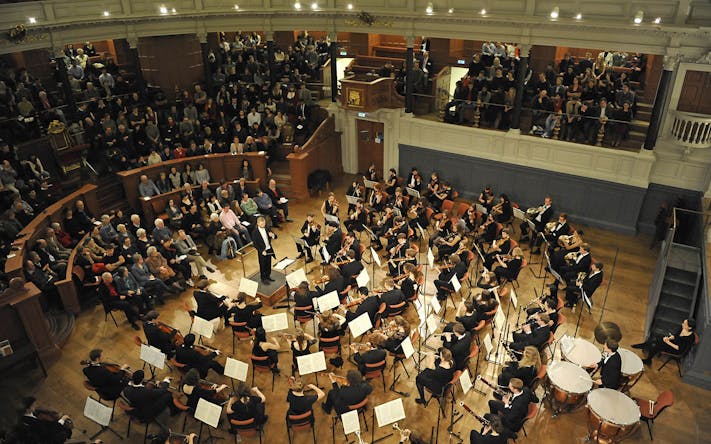Along Broad St on a chilly November evening the far end twinkled with cheery Christmas lights while outside the Sheldonian Theatre glared a vast industrial steel container smothered in graffiti informing the passer-by that BANKS GREED = FOOD BANKS. It's odd how connections pop up from all angles; in this case how this graffito might be linked to the biography of Sergei Rachmaninov who came from a rich Russian landowning family, profiting from serf labour until its abolition in 1861, but whose fortunes plummeted into economic decline as the banks foreclosed on one estate after another, until what remained was seized by the state in the 1917 revolution. In consequence, from his mid-teens on until much later in life when piano concert tours filled the coffers, Rachmaninov was short of money.
This concert was given by very largely student musicians, the 60-strong Millennium Orchestra having put in seven rehearsals for this performance. I take it the programming brief is to seek out works for a large ensemble, offering plenty of scope for the several sections of the orchestra. Prokofiev's ballet music Cinderella Suite No. 1 (of three such; ballet from 1940, suites from 1945) slips into that role snugly, requiring a four-strong percussion section and a numerous brass and woodwind contingent. Glass slippers, behaviourally if not physiognomally-challenged sisters and fairy godmothers, the age-old elements of Cinderella were a natural subject for a musical storyteller like Prokofiev, and his full ballet score of which Suite No. 1 is an abridgement constitutes, along with Romeo and Juliet from five years earlier, two of his major works.
The wistful introduction, capturing I think Cinderella's plight, and introducing a delightful melody soon gives way to the Sisters scrapping over a shawl, characterised by shrill comments in the winds, while their relentless complaining is heard in the strings and percussion. The upper string section sounded a bit scratchy here, taking time to warm up. Conductor David O'Neill adhered faithfully to the marked tempos through both works, but his style was very much 'head-down in the score' and I wasn't conscious of that injection of energy from him or close attention to the discrete orchestra sections that perhaps a more experienced conductor can bring in performance. That said, there was ample evidence that the players were well-versed in their material, and no doubt Dr O'Neill's input in rehearsal was substantial.
Throughout there were strong echoes of Romeo and Juliet in a notably well-played duet between flute and piccolo, later when we were swept up by the strings into the pungent waltz, and then again in Midnight as Cinderella loses her slipper fleeing from the ball. Here the percussion section made hay as a ticking clock (a snappy wood block) counts down to midnight. The panic in the music refers noticeably to the stabbing of Tybalt, the Prince of Cats, in the earlier ballet.
After the interval came Rachmaninov's mammoth - and perhaps too long - Symphony No. 2 from 1906, in a way a prototype for his Piano Concerto No. 3. The large brass section remained, including trombone and tuba, and from low cellos and double-basses came the recurring, brooding melody at the start. In the following Scherzo, there's an insistent little fanfare on flutes and clarinets that reminded me of similar fanfares in the composer's Variations on a Theme of Paganini.
For this work I was seated directly above the trumpets and trombone, and in the Scherzo a slight vibration was discernible in the seating as they and the four horns vied for possession of the theme. In the Andante the sustained clarinet solo was played with smooth control and delicate tone by Tom Dixon, a D.Phil. postgraduate who told me he's in his sixth year with the orchestra. The strings struck out boldly in a rushing tarantella and then chattering triplets in the Allegro Vivace as we headed for the hurricane conclusion.




